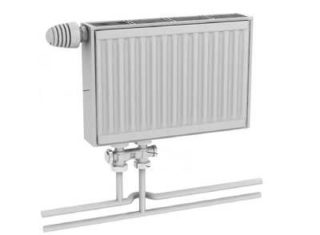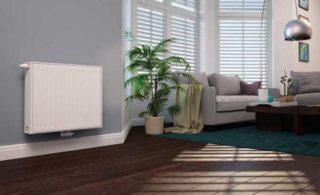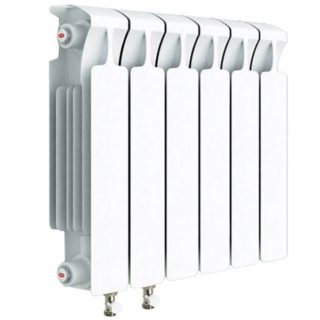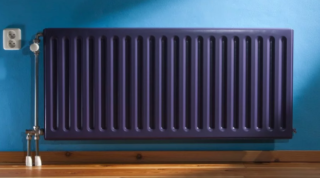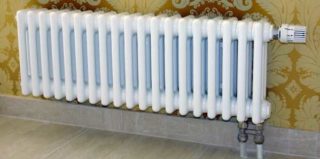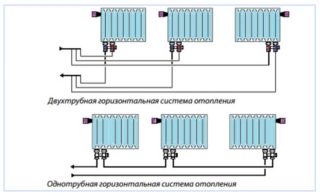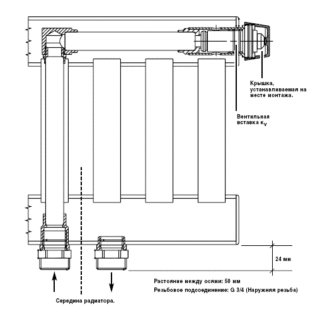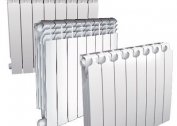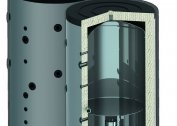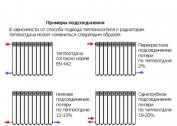A correctly selected connection scheme for heating radiators provides an efficient water supply while minimizing losses in terms of power. For each situation, you need to select a separate scheme, taking into account the features of the interior, the type of room and other nuances. Modern radiators with a lower connection can fit into any technological interior, since hidden piping is provided during their installation. This is the best option for those who plan to repair a house or apartment.
What is the bottom radiator connection
This connection method makes it possible to remove pipes from prominent places according to the standard scheme, which is more often used in private houses than in apartments. They are connected to the radiator and cleaned inside the floor, which allows you to free up additional space and make the interior more accurate. Since the supply of thermal carrier from below is unnatural, because directed against gravity, radiators cannot be brought in this way in open systems with standard circulation.
The one-way method is considered more complicated, since in such a situation the local resistance of the radiator will increase additionally due to the passage of two oncoming channels through one branch. The best option for connecting central heating batteries from below will be a two-pipe type system or a radial decoupling. This method is not recommended for single-tube schemes, since problems may arise with balancing the system and ensuring its full operation.
The bottom connection can be two-sided or one-sided, in the first case, it is necessary to additionally use circulation pumps with intensive pressure and to revise the hydraulic calculation system.
Pros and cons of lower eyeliner
The lower connection has many advantages, hiding pipes makes it easy to integrate them into interiors with complex design solutions and select good options based on the layout of the room. It must be remembered that the radiator will heat up faster and more strongly in the lower part due to the accelerated passage of heat carrier current. Despite uneven heating and a slight decrease in efficiency due to blockages or accumulations of air, such radiators perform their basic functions in the same way as with a standard connection. There are several types of eyeliner:
- in the direction from top to bottom;
- with one-way connection;
- with versatile connection;
- with connection in the center.
The list of minuses includes difficulties with connecting, and it will not be easy to create an optimal climate in the room if there is not enough space for connecting heat transfer units. There is little space below to accommodate the fittings. In this area, a crane is installed, a valve that allows you to adjust the temperature - they also require additional space. If you develop a rational wiring diagram and plan all the details, these problems can be easily compensated by the most thoughtful installation.
When installing from below and from the sides, regardless of the layout, always follow the installation requirements. It is very important to consider the proportions between the width of the battery itself and the window opening.
Types of materials
The most practical is the diagonal circuit for connection, due to which a good level of thermal volume is achieved, coolants are evenly calculated, and the required temperature gradient is provided and due to it convection becomes more intense. During the supply of pipes from below, the water flow should go diagonally, starting from the top edge and reaching the bottom.
Not all types of radiators are suitable for installation; modern models differ depending on the material of manufacture and have their own characteristics.
Bimetallic
Bimetallic batteries occupy one of the first places in the ranking in terms of installation frequency and consist of two types of metals, most often copper and stainless steel. Bimetal radiators with a lower standard eyeliner are easily mounted in any type of heating system and do not cause difficulties during installation. Copper and steel perfectly tolerate the effects of the most aggressive environments. The pipes of such radiators can be located horizontally or occupy a vertical position, which provides free circulation of the coolant. Of the minuses of such batteries, their high cost is usually noted. Models of Global, Kermi and Rifar brands are available for sale.
Aluminum
Thin aluminum batteries have many advantages over their counterparts. They warm the rooms well due to high thermal conductivity, are characterized by an optimal level of strength and are able to withstand pressure up to 16 atmospheres. In such radiators, you can independently adjust the temperature, their low weight significantly facilitates the installation process, transportation and general maintenance. Various designs of aluminum radiators are available on the market, including modern options that can fit into the interior. You can purchase models from Hygiene, Plan, Purmo, Sira, and Ventil 350.
Steel
Steel batteries can be connected with a diagonal and one-sided mounting option. They are convenient and practical, able to withstand temperatures up to 110-120 degrees. Like aluminum, these batteries are quite cheap and do not cause problems in the process of maintenance and installation. They have only one significant drawback - after a while they are exposed to rust, due to which they can fail, therefore they are not considered the most reliable. Tubular and panel models with antifreeze are widely distributed, which are still in demand among buyers.
Cast iron
Cast-iron radiator models are gradually being replaced by batteries from more practical metals, since they do not meet the modern requirements for installation. They are quite durable and practical, a lower connection is also available for them, but the low level of reliability of the material makes them increasingly replaced by more affordable models of steel or aluminum.
Cast iron radiators are rarely available for sale and are becoming less popular.
Varieties of bottom connection
There are only two options for bottom piping: one-way and versatile. In the first version, the pipes are connected only on one side, with this option, the hot coolant penetrates through the cork from above, and the cold is discharged through the bottom. Versatile wiring implies the location of the entrance and exit from different sides, this option is ideal for heating individual heating structures. Its main advantage is that hot water is able to go in any direction, also with this option is less than the length of the feed and the opposite effect.
Versatile connection
In the case of the lower multi-sided connection, the connection is made through the supply and return flow in the end radiator pipes located at the opposite ends at the bottom. Such a connection scheme is less profitable compared to the side, because in this case the heat loss will be 20-25%. Nevertheless, it suits most of the owners of the premises, since when choosing it, the radiators are easy to connect to the main pipes hidden under the floor.
One way connection
One-sided connection of the side type, in which the coolant inlet and outlet are located on the side, is most popular among apartment owners in multi-storey buildings, since its main advantage is the most convenient installation, during which the heating risers are installed vertically. The optimal level of heat transfer is achieved when hot water enters the upper pipe, and the cooled liquid is discharged from the pipe from below.
Mounting Features
Mounting radiators with a lower connection will not be difficult, if you approach this issue responsibly, consider the design of such batteries and safety precautions. They can be connected independently if all the necessary tools are available or you can contact specialists if you do not have the skills to work with such equipment. It is best to connect radiators in the early stages of repairing a house or apartment, since with such an installation, pipes are laid inside a wall or floor. This factor must be considered if concrete floor screed is planned.
Typically, each radiator comes with a personal mounting kit or a unit with which the device is easily mounted on the wall. The installation process itself will depend on the chosen layout of the pipeline, it can be located in the wall or in the floor, as well as between the floor and the radiator, taking into account the characteristics of the room.
The efficiency of heating radiators with a standard bottom connection does not depend on the location of the pipes, since they are always hidden so as not to spoil the overall appearance of the interior.
